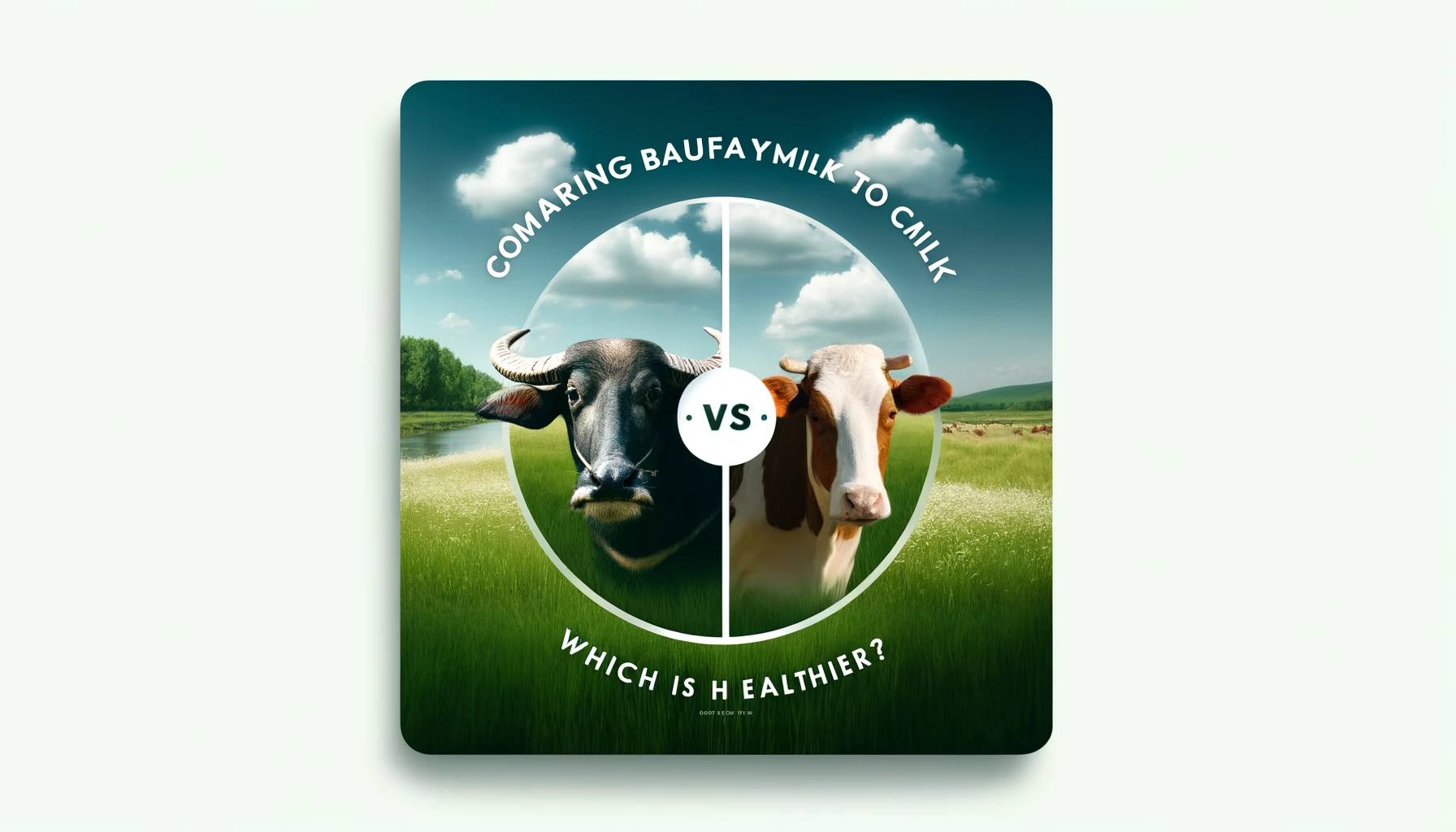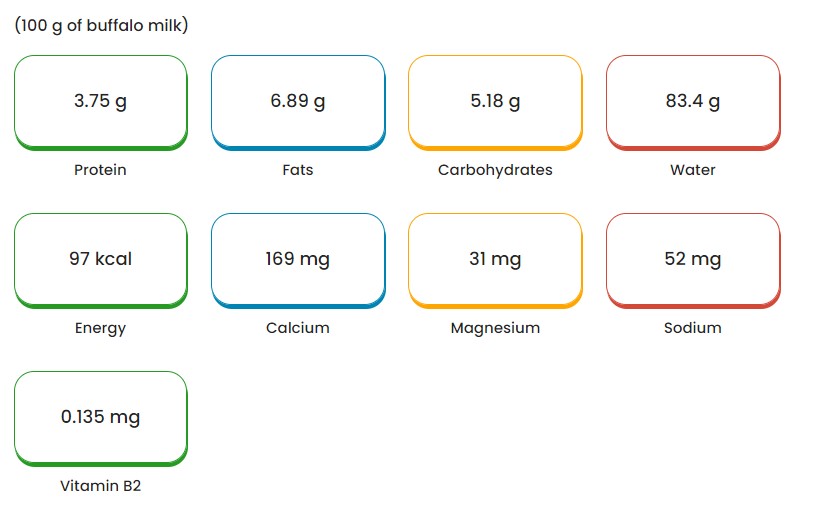
The Nutritional Benefits of Buffalo Milk
Buffalo milk offers a rich array of nutritional benefits that make it a noteworthy alternative to conventional cow’s milk. This section explores the essential nutrients found in buffalo milk and the reasons behind its growing popularity among health-conscious individuals.
High Protein Content
One of the standout qualities of buffalo milk is its high protein content. The protein in buffalo milk is not only more abundant but also of higher quality compared to cow’s milk. This makes buffalo milk especially valuable for muscle repair and growth, as well as providing enhanced satiety, which can aid in weight management. The rich protein profile supports the body’s structural and functional needs, making it an excellent choice for both children and adults striving for a balanced diet.
Rich in Calcium and Other Minerals
Buffalo milk is exceptionally high in calcium, vital for maintaining strong bones and teeth. In addition to calcium, it is a good source of important minerals such as magnesium, potassium, and phosphorus. These minerals are crucial for various bodily functions, including the regulation of blood pressure, and the maintenance of heart health and bone density. Consuming buffalo milk can contribute to a more robust and fortified mineral intake, favoring overall health and wellness.
Beneficial Fats | ¿is buffalo milk good for health?
Despite its higher fat content, buffalo milk contains beneficial fats that can improve lipid profiles and offer cardio-protective benefits. These fats are mostly saturated fats but also include essential fatty acids, which contribute to better cardiovascular health. Moreover, the natural fat content of buffalo milk provides it with a rich, creamy texture that enhances its taste, making it a preferred choice for various culinary preparations.
Vitamins and Antioxidant Properties
Buffalo milk is also a significant source of fat-soluble vitamins such as Vitamin A, Vitamin D, Vitamin E, and Vitamin K. These vitamins play an essential role in maintaining vision, skin health, immune function, and blood coagulation. Additionally, buffalo milk contains higher levels of antioxidants compared to cow’s milk, which can help combat oxidative stress and reduce the risk of chronic diseases.

Organic Farming Practices for Buffalo Milk Production
Organic farming practices are pivotal for enhancing the quality of buffalo milk while ensuring sustainability and ecological balance. This section delves into the methodologies employed in organic buffalo milk production, emphasizing the benefits not only to the product but also to the environment and the animals themselves. Organic methods focus on the welfare of the buffaloes, the non-use of synthetic inputs such as pesticides and fertilizers, and the preservation of the ecosystem.
Principles of Organic Buffalo Farming
Organic buffalo farming rests on several core principles including animal welfare, environmental preservation, and sustainable resource use. This approach prohibits the use of genetically modified organisms (GMOs) and encourages the rotation of pasture lands to maintain soil fertility and reduce soil erosion. The buffaloes are raised in a stress-free environment, allowed to graze freely which is crucial for their health and the quality of milk they produce.
Techniques and Innovations in Organic Farming
To maintain the integrity of organic milk, farmers implement a variety of innovative techniques. These include integrated pest management, the use of organic fodder, and holistic veterinary practices that eschew synthetic drugs. Technological advancements such as automated milking systems and data-driven pasture management also play a significant role. These innovations help in maintaining consistent milk quality and improving the overall efficiency of the farming process while adhering to organic standards.
Health Benefits of Organic Buffalo Milk

Organic buffalo milk is not only a delicious alternative to traditional cow’s milk, but it also boasts a variety of impressive health benefits. Rich in high-quality proteins, vitamins, and minerals, this type of milk contributes significantly to a balanced diet. It is particularly noted for its high content of calcium and magnesium, which are essential for maintaining strong bones and teeth. Furthermore, organic buffalo milk contains lower cholesterol levels compared to conventional milk, making it a heart-friendly option. Its rich, creamy texture provides a satisfying taste that can enhance any dairy-based recipe while contributing substantial nourishment.
Another notable advantage of organic buffalo milk is its content of bioactive compounds such as immunoglobulins, which boost the immune system’s effectiveness. These compounds help in combating various diseases by enhancing body immunity. Additionally, the organic nature of the milk ensures that it is free from antibiotics, synthetic hormones, and pesticides commonly used in conventional dairy farming. This aspect greatly reduces the risk of chemical-associated health issues and promotes a cleaner, more natural diet. Integrating organic buffalo milk into your routine could be a step toward a healthier lifestyle, given its rich nutritional profile and natural purity.
Lactose Content and Digestibility
Organic buffalo milk offers a viable alternative for those with lactose intolerance. Surprisingly, despite its rich consistency, buffalo milk has a lower lactose content than cow’s milk, which may be easier to digest for some individuals. This can be particularly beneficial for those who experience discomfort from dairy products yet still want to enjoy the health benefits of milk. Furthermore, the fat molecules in buffalo milk are larger and more spread out, which contributes to its creaminess and might also facilitate easier digestion and absorption in the human body.
Antioxidant Properties
The consumption of organic buffalo milk is also associated with antioxidant benefits. It contains significant amounts of antioxidants like tocopherol and beta carotene which help in reducing oxidative stress in the body. These antioxidants play a crucial role in protecting cells against damage from free radicals, potentially lowering the risk of chronic diseases such as cancer and cardiovascular disease. Regular intake of buffalo milk could thereby contribute to enhancing overall health and longevity by leveraging its antioxidant potential.
Comparing Buffalo Milk to Cow Milk: Which is Healthier?

Buffalo milk and cow milk are both nutritious dairy options, but they differ in several key nutritional aspects. This section delves into the comparative analysis of both types of milk to determine which might be healthier based on various dietary needs. It is essential to look at factors such as fat content, protein levels, mineral content, and digestibility to make an informed decision.
Nutritional Content Comparison
When comparing the nutritional content of buffalo milk to cow milk, it is evident that buffalo milk is richer in certain nutrients. It contains higher levels of fat, protein, calcium, and phosphorus. This higher concentration of minerals and proteins makes it a potent source of nutrients necessary for bone health and muscle building. However, the higher fat content might be a concern for individuals managing caloric intake or cholesterol levels.
Digestibility and Allergic Reactions
Despite its rich nutritional profile, buffalo milk has a higher casein content, which can influence digestibility and allergenic potential. For some people, especially those with certain dietary sensitivities or lactose intolerance, cow milk may be easier to digest due to its lower fat and casein levels. Additionally, cow milk is generally more available and undergoes more stringent hypoallergenic processing methods, making it potentially more suitable for people with milk allergies.
Taste and Culinary Uses
The taste of buffalo milk is generally described as creamier and richer compared to the lighter and somewhat watery profile of cow milk. This makes buffalo milk especially favored in the production of high-fat dairy products like cheese, yogurt, and traditional desserts. In culinary arts, the choice between buffalo and cow milk often depends on the desired richness and texture of the dish being prepared.
How to Incorporate Buffalo Milk into Your Diet
In this section, we focus on various strategies and recipes that will allow you to seamlessly integrate buffalo milk into your daily diet. Buffalo milk, known for its rich texture and high nutritional content, is a versatile ingredient that can enhance the quality of many dishes. From breakfast to dinner, incorporating buffalo milk can boost your intake of essential nutrients such as calcium, protein, and vitamins.
Using Buffalo Milk in Everyday Cooking
Buffalo milk can be used as a nutritious substitute for cow’s milk in almost any recipe. Its creamy texture makes it especially suitable for creamy soups, sauces, and baked goods. You can start by using it in your morning coffee or tea to add richness. For lunch or dinner, consider preparing a creamy buffalo milk-based soup or adding it to mashed potatoes for extra creaminess and flavor. The high fat content of buffalo milk lends itself well to creating thick and velvety textures in culinary preparations.
Healthy Buffalo Milk-Based Drinks and Smoothies
For a refreshing and nutritious beverage, try incorporating buffalo milk into your smoothies. Mixing buffalo milk with fruits like bananas, berries, or mangoes can provide a delicious, creamy smoothie rich in nutrients. Additionally, consider traditional drinks like lassi, a popular Indian yogurt-based drink, which can be made using buffalo milk for an authentic and healthier version. These drinks not only offer a tasteful delight but also contribute significantly to your daily nutrient intake, making them a perfect choice for breakfast or as a mid-day refreshment.
Desserts and Sweets with Buffalo Milk
Leverage the uniquely rich and creamy texture of buffalo milk to elevate your dessert recipes. Traditional desserts like rice pudding, custards, and ice creams can be significantly enhanced using buffalo milk. The milk’s natural sweetness and creaminess add a luxurious texture to desserts, making it a superior choice for sweet dishes that are both indulgent and nourishing. Experimenting with buffalo milk in your dessert recipes can transform standard sweets into extraordinary culinary experiences.

The Environmental Impact of Producing Buffalo Milk
Buffalo milk production has unique environmental implications compared to other types of dairy production. Understanding these impacts is essential for sustainable farming practices and informed consumer choices. This section explores the environmental aspects of producing buffalo milk, focusing on its carbon footprint, use of resources, and effects on biodiversity.
Carbon Emissions and Energy Use
The production of buffalo milk involves various stages, each contributing to its total carbon emissions. From the maintenance of buffalo herds to the processing and transportation of milk, each step utilizes energy and emits carbon dioxide. Research indicates that buffalo milk may have a slightly different carbon footprint than cow’s milk due to the inherent differences in digestion and yield per animal. Addressing these emissions is crucial for reducing the overall environmental impact of this industry.
Water and Land Usage
Buffalo milk production is significantly dependent on the availability of water and land. Buffaloes require large grazing fields and considerable amounts of water for drinking and maintaining hygiene. Sustainable practices in managing land and optimizing water use are vital for making buffalo milk production more eco-friendly. Land management practices, such as rotational grazing, can help maintain soil health and increase the land’s capacity to sequester carbon, further aiding in environmental conservation.
Impact on Biodiversity
The way buffalo herds are managed can have profound effects on local biodiversity. Proper herd management ensures minimal disruption to native wildlife. Moreover, organic practices in buffalo farming, such as avoiding synthetic pesticides and fertilizers, can enhance biodiversity by allowing a healthier ecosystem. These practices not merely support a diverse array of species but also contribute to the resilience of the farming system against pests and diseases.
Case Studies: Successful Organic Buffalo Milk Farms
This section examines various successful organic buffalo milk farms around the world, highlighting their methodologies, achievements, and contributions to the industry and environment. By analyzing these practical examples, we can gain insights into effective strategies and best practices that have driven the success of these enterprises. Each case study focuses on aspects such as innovative farming techniques, sustainable practices, and the economic viability of running an organic buffalo milk farm.
Overview of Selected Farms
Selected farms from diverse geographical locations such as Italy, India, and the United States are introduced. These farms are renowned for their commitment to organic farming standards and have exhibited significant influence on local and international markets. This subsection details each farm’s history, primary objectives, and the challenges they faced during their developmental stages. This comprehensive overview provides a baseline understanding of the operational scale and scope of organic buffalo milk production worldwide.
Innovative Farming Techniques
This subsection delves into the innovative farming techniques employed by these farms to sustainably increase production while maintaining high standards of animal welfare. Techniques such as rotational grazing, biodynamic farming, and the integration of renewable energy sources are discussed. The emphasis is on how these methods not only contribute to the health of the buffaloes but also minimize environmental impacts, thereby supporting the sustainability of the farms long-term.
Marketing and Sales Strategies
Exploration of effective marketing and sales strategies that have enabled these farms to thrive in a competitive market forms the crux of this subsection. Strategies include direct selling, community-supported agriculture (CSA), online marketing, and participation in organic and farmers’ markets. Highlighted also are collaborations with gourmet restaurants and participation in local and international organic trade fairs, which have bolstered both their visibility and profitability.
Impact on Local Communities and Beyond
The influence of successful organic buffalo milk farms on local communities and their broader economic and ecological impact is examined here. It includes employment opportunities, enhancement of local biodiversity, and the promotion of regional and global sustainability goals. The narrative showcases how these farms serve as models of how agriculture can be both productive and environmentally sound, inspiring further adoption of organic practices globally.
Future Trends in Organic Buffalo Milk Market
The organic buffalo milk market is evolving rapidly, driven by increasing consumer awareness about health and environmental issues. As more people seek out natural and organic food products, the demand for buffalo milk, known for its rich nutritional profile, is expected to grow. Industry experts predict significant growth in this sector, influenced by health trends and sustainability practices. Key future trends include technological advancements in milk processing, expansion of product lines (such as organic buffalo cheese and yogurt), and increased global distribution channels.
Furthermore, the rise of e-commerce and digital platforms will play a crucial role in the accessibility and visibility of organic buffalo milk products. Consumer preferences are shifting towards traceability and transparency in food sources, pressing producers to adopt more robust and transparent supply chains. This trend is likely to foster deeper connections between organic buffalo milk farmers and their customers, potentially leading to a surge in farm-to-table models and direct-to-consumer sales strategies.
